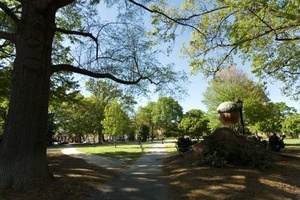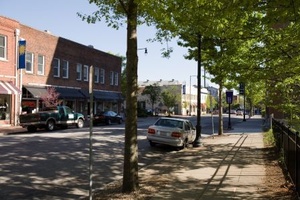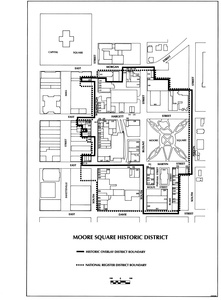Developed 1870s through 1930s
Moore Square Historic District is home to Raleigh's "Black Main Street" and the City Market
While the district is named for one of the five park squares laid out in the original plan of Raleigh, its character is overwhelmingly commercial. The area is close to south Raleigh's historically African American neighborhoods, and the proximity made the section of East Hargett Street between South Wilmington and South Blount Streets a center of African American-owned businesses. This section of East Hargett Street was known historically as Raleigh's Black Main Street.
Buildings date from the late nineteenth through early twentieth centuries. Reflecting the size of the city around that time, they are small in scale and modest in detailing. An exception is the 1914 Mission-style City Market that faces Moore Square. The building reflects Raleigh's importance in agricultural trade in the early twentieth century.
Heavy concentrations of two- to three-story brick commercial buildings line South Wilmington and East Hargett Streets. Smaller groups of similar buildings stand along East Martin and South Blount Streets. A notable infill project is the 1999 Exploris Museum at the corner of East Hargett and South Blount Streets, overlooking the northwest corner of the park; older infill includes parking decks and a bus transfer station.
History
During the late nineteenth and early twentieth centuries, small-scale commercial development replaced the earlier nineteenth-century residential district that had developed around Moore Square. As Raleigh's business district grew after the end of the Civil War, commercial development spread both east and west of Fayetteville Street, the city's main business thoroughfare.
Businesses lined South Wilmington Street as early as the 1870s. These tended to be saloons, cafes, grocery stores, blacksmiths, bootmakers, and boarding houses. The ca. 1870 Carolina Boarding House at the northeast corner of South Wilmington and East Hargett Streets is one of the older buildings in the district. It operated as a hotel and grocery before becoming a furniture store. For much of the twentieth century, the Italianate building housed the Heilig-Levine Furniture Store.
Another surviving nineteenth-century building, although much altered, is the 1879 Tabernacle Baptist Church at the northwest corner of East Hargett and South Person Streets. Originally a modest brick Gothic Revival church, the building was remodeled into a Romanesque church late in the nineteenth century and back to a Gothic Revival building in the early years of the twentieth century.
The 1914 construction of the City Market south of Moore Square had a profound impact on the streets surrounding the square. The growth of the trucking industry fueled the success of the market, which in turn generated a surge in the number of grocery stores on surrounding streets.
In the 1920s, increasingly stringent racial segregation practices pushed African American businesses out of several commercial areas and they began relocating to East Hargett Street between South Wilmington and South Blount Streets. The block became Raleigh's Black Main Street. The Farmers and Mechanics Bank on East Hargett Street (just outside the Moore Square District) helped finance many African American investments and businesses.
Like many urban neighborhoods in the second half of the twentieth century, the area went into decline in response to the developing suburbs and suburban shopping centers. The last decade of that century and the early years of the twenty-first century have brought a robust resurgence to the streets surrounding Moore Square.
See Also
- Moore Square National Register Nomination
- The Special Character of the Moore Square Historic District
- Common Beauty: History of the Physical Form and Uses of Moore Square
 |
This entry is about Historic Resources in Raleigh. Initial information provided by the Raleigh Historic Development Commission. You can find more entries about Raleigh's historic resources here. |





